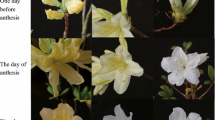Abstract
The basis of the novel cream/yellow flower color found in two Sandersonia aurantiaca lines was examined as part of a project to develop new colors for this cut flower crop in New Zealand. The original color, bright orange, is due to the accumulation of the carotenoid pigments zeaxanthin and β-cryptoxanthin. The cream/yellow lines have much lower levels of total carotenoid pigments (17% and 21%) in their tepal tissue compared to the wild type progenitor. Microscopic analysis of epidermal cells showed alteration in the pigment cluster bodies of tepal tissue of the cream/yellow lines compared to the orange wild type. HPLC analysis of the pigments showed that one cream/yellow line (Y-H) produced the same pigment profile as the wild type (zeaxanthin and β-cryptoxanthin). In comparison, the other cream/yellow line (Y-S) produced the carotenoid profile normally found in green vegetative tissue (β-carotene and lutein). Analysis of carotenoid biosynthetic gene expression in Sandersonia indicated that the cream/yellow Y-H line showed expression patterns similar to the wild type, and gene expression in the Y-S line is decreased relative to the wild type and the Y-H line.
Similar content being viewed by others
References
Alba, R., M. Cordonnier-Pratt & L.H. Pratt, 2000. Fruit-localized phytochromes regulate lycopene accumulation independently of ethylene production in tomato. Plant Physiol 123: 363-370.
Al-Babili, S., J. von Lintig, H. Haugruck & P. Beyer, 1996. A novel, soluble form of phytoene desaturase from Narcissus pseudonarcissus chromoplasts is Hsp70-complexed and competent for flavinylation, membrane association and enzymatic activation. Plant J 9: 601-612.
Brundell, D.J. & J.L Reyngoud, 1986. Observations on the development and culture of Sandersonia. Acta Hort 177: 439-447.
Church, G.M. & W. Gilbert, 1984. Genomic sequencing. Proc Natl Acad Sci USA 81: 1991-1995.
Corona, V., B. Aracri, G. Kosturkova, G.E. Bartley, L. Pitto, L. Giorgetti, P.A. Scolnik & G. Giuliano, 1996. Regulation of a carotenoid biosynthesis gene promoter during plant development. Plant J 9: 505-512.
Cunningham, F.X. & E. Gannt, 1998. Genes and enzymes of carotenoid biosynthesis in plants. Ann Rev Plant Physiol Plant Mol Biol 49: 557-583.
Deruere, J., S. Romer, A. d'Harlingue, R.A. Backhaus, M. Kuntz & B. Camara, 1994. Fibril assembly and carotenoid overaccumulation in chromoplasts: A model for supramolecular lipoprotein structures. Plant Cell 6: 119-133.
Eason, J.R. & D. Webster, 1995. Development and senescence of Sandersonia aurantiaca (Hook.) flowers. Sci Hort 63: 113-121.
Eason, J.R., J.W. Johnston, L. de Vre, B.K. Sinclair & G.A. King, 2000. Amino acid metabolism in senescing Sandersonia aurantiaca flowers: cloning and characterization of asparagine synthetase and glutamine synthetase cDNAs. Aust J Plant Physiol 27: 389-396.
Emter, O., H. Falk & P. Sitt, 1990. Specific carotenoids and proteins as prerequisites for chromoplast tubule formation. Protoplasma 157: 128-135.
Fraser, P.D., M.R. Truesdale, C.R. Bird, W. Schuch & P.M. Bramley, 1994. Carotenoid biosynthesis during tomato fruit development. Plant Physiol 105: 405-413.
Hugueney, P., F. Bouvier, A. Badillo, J. Quennemet, A. d'Harlingue & B. Camara, 1996. Developmental and stress regulation of gene expression for plastid and cytosolic isoprenoid pathways in pepper fruits. Plant Physiol 111: 619-626.
King, G.A. & K.M. Davies, 1992. Identification, cDNA cloning, and analysis of mRNAs having altered expression in tips of harvested Asparagus spears. Plant Physiol 100: 1161-1169.
Lewis, D.H., S.J. Bloor & K.E. Schwinn, 1998. Flavonoid and carotenoid pigments in flower tissue of Sandersonia aurantiaca (Hook). Sci Hort 72: 179-192.
Lois, L.M., M. Rodriguez-Conception, F. Gallego, N. Campos & A. Boronat, 2000. Carotenoid biosynthesis during tomato fruit development: regulatory role of 1-deoxy-D-xylulose 5-phosphate synthase. Plant J 22: 503-513.
Morgan E.R., G.K. Burge, J.F. Seelye, J.E. Grant, A.G.F. Warren & D. Brundell, 2001. Wide crosses in the Colchicaceae: Sandersonia aurantiaca (Hook.) × Littonia modesta (Hook). Euphytica 121: 343-348.
Pecker, I., D. Chamovitz, H. Linden, G. Sandmann & J. Hirschberg, 1992. A single polypeptide catalyzing the conversion of phytoene to ζ-carotene is transcriptionally regulated during tomato fruit ripening. Proc Nat Acad Sci USA 89: 4962-4966.
Prescott, A. & C. Martin, 1987. Rapid method for the quantitative assessment of levels of specific mRNAs in plants. Plant Mol Biol Rep 4: 219-224.
Rissler, H.M. & B.J. Pogson, 2001. Antisense inhibition of the betacarotene hydroxylase enzyme in Arabidopsis and the implications for carotenoid accumulation, photoprotection and antenna assembly. Photo Res 67: 127-137.
Romer, S., A. Saint-Guily, F. Montrichard, M.L. Schantz, J.H. Weil, R. Schantz, M. Kuntz & B. Camara, 1992. Characterization of cDNAs which encode enzymes involved in chromoplast differentiation and carotenoid biosynthesis in Capsicum annum. In: J.H. Argyroudi-Akoyunoglou (Ed.), Regulation of Chloroplast Biogenesis, pp. 63-69. Plenum Press, New York.
Sun, Z., E. Gantt & F.X. Cunningham, 1996. Cloning and functional analysis of the β-carotene hydroxylase of Arabidopsis thaliana. J Biochem Chem 271: 24349-24352.
Vainstein, A., A.H. Halevy, I. Smirra & M. Visnhevetsky, 1994. Chromoplast biogenesis in Cucumis sativus corollas. Plant Physiol 104: 321-326.
Vishnevetsky, M., M. Ovadis, A. Zuker & A. Vainstein, 1999. Molecular mechanisms underlying carotenogenesis in the chromoplast: multilevel regulation of carotenoid-associated genes. Plant J 20: 423-431.
Wellburn, A.R., 1994. The spectral determination of chlorophylls a and b, as well as total carotenoids, using various spectrophotometers of different resolution. J Plant Physiol 144: 307-313.
Zsila, F., J. Deli & M. Simonyi, 2001. Color and chirality: carotenoid self-assemblies in flower petals. Planta 213: 937-942.
Author information
Authors and Affiliations
Rights and permissions
About this article
Cite this article
Nielsen, K.M., Lewis, D.H. & Morgan, E.R. Characterization of carotenoid pigments and their biosynthesis in two yellow flowered lines of Sandersonia aurantiaca (Hook). Euphytica 130, 25–34 (2003). https://doi.org/10.1023/A:1022328828688
Issue Date:
DOI: https://doi.org/10.1023/A:1022328828688




